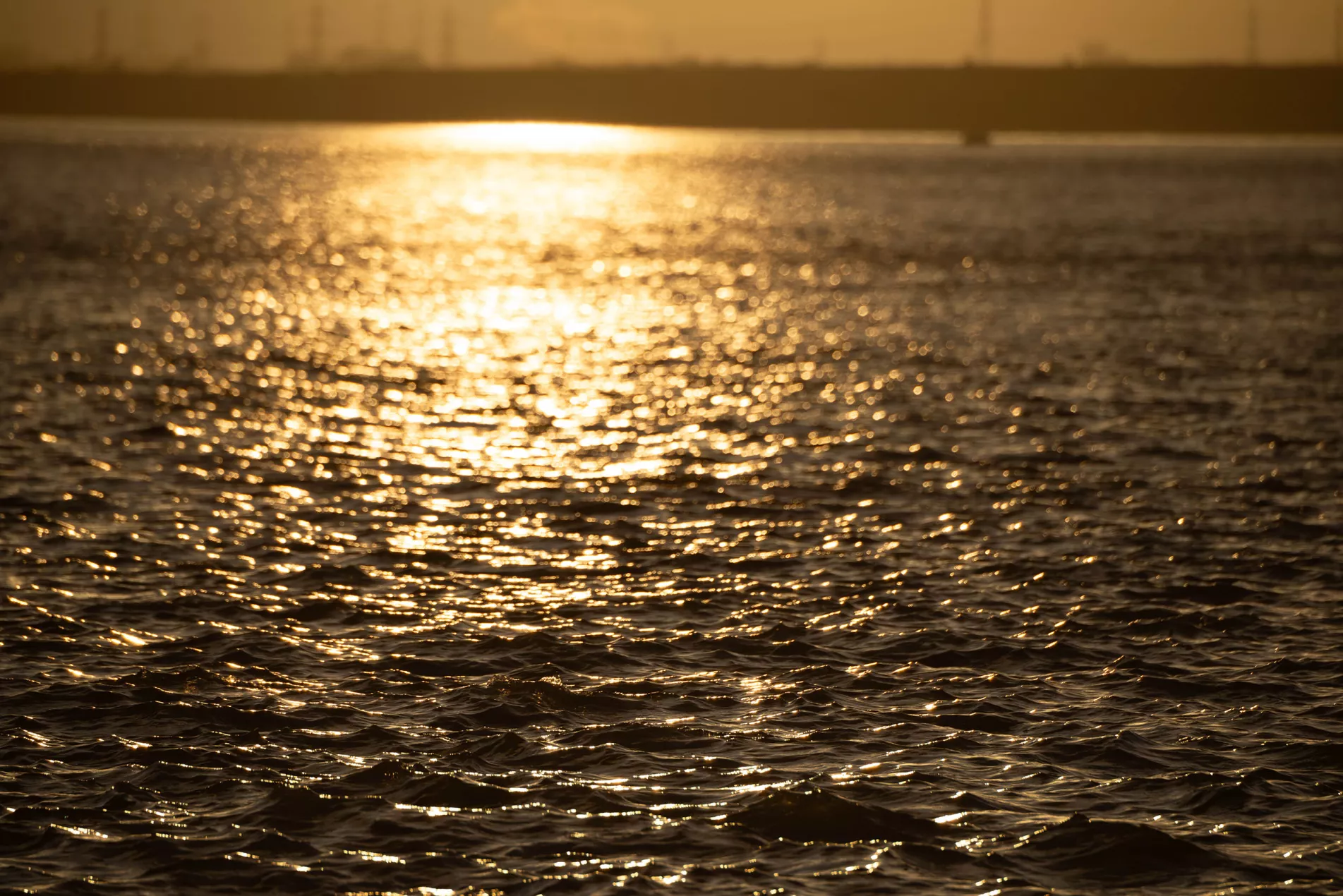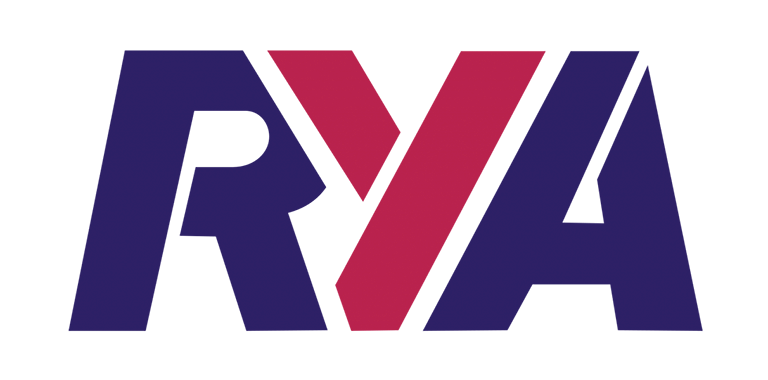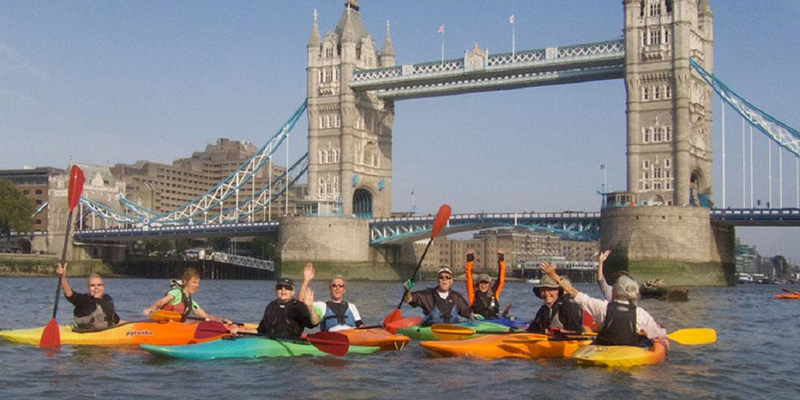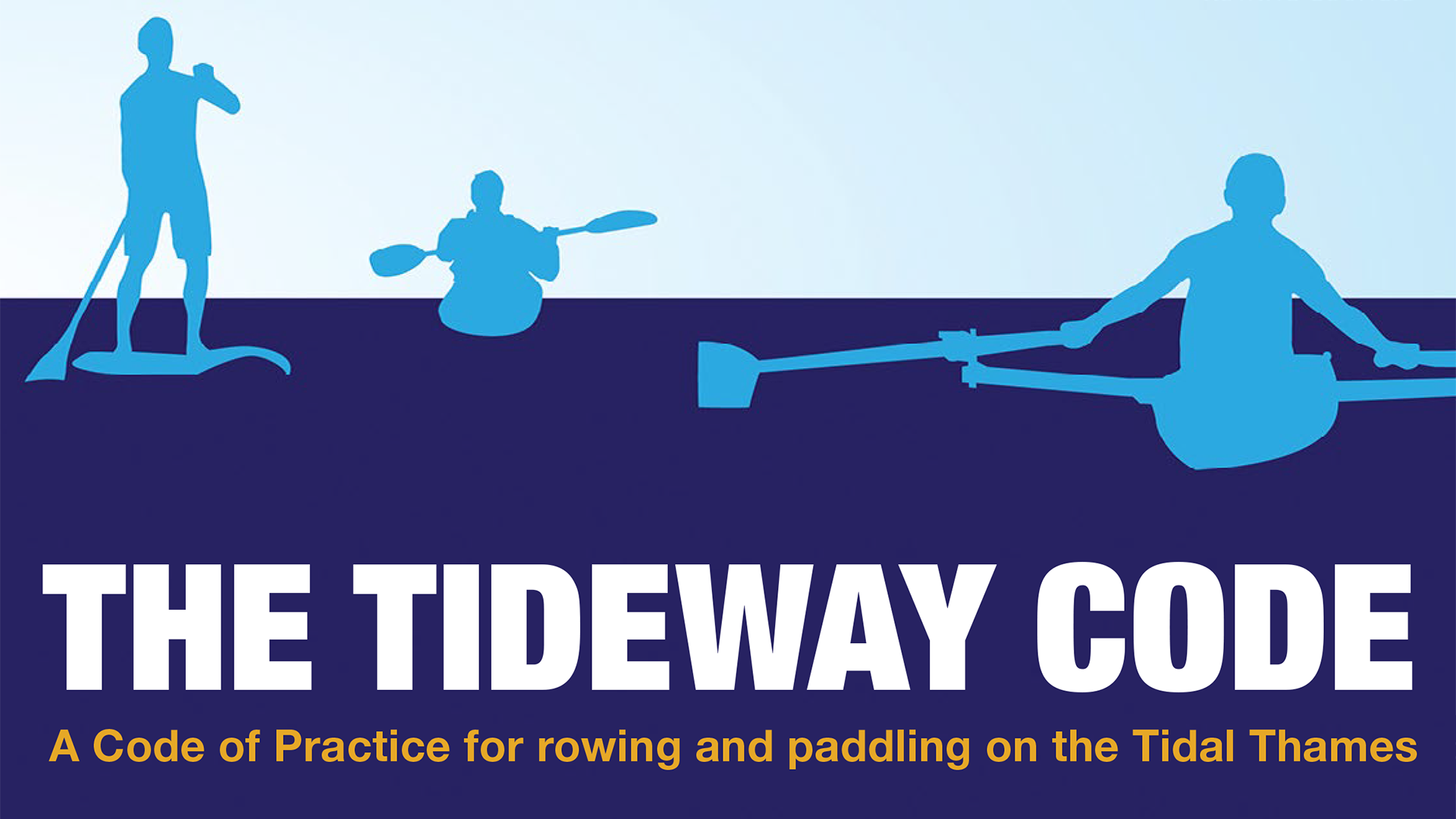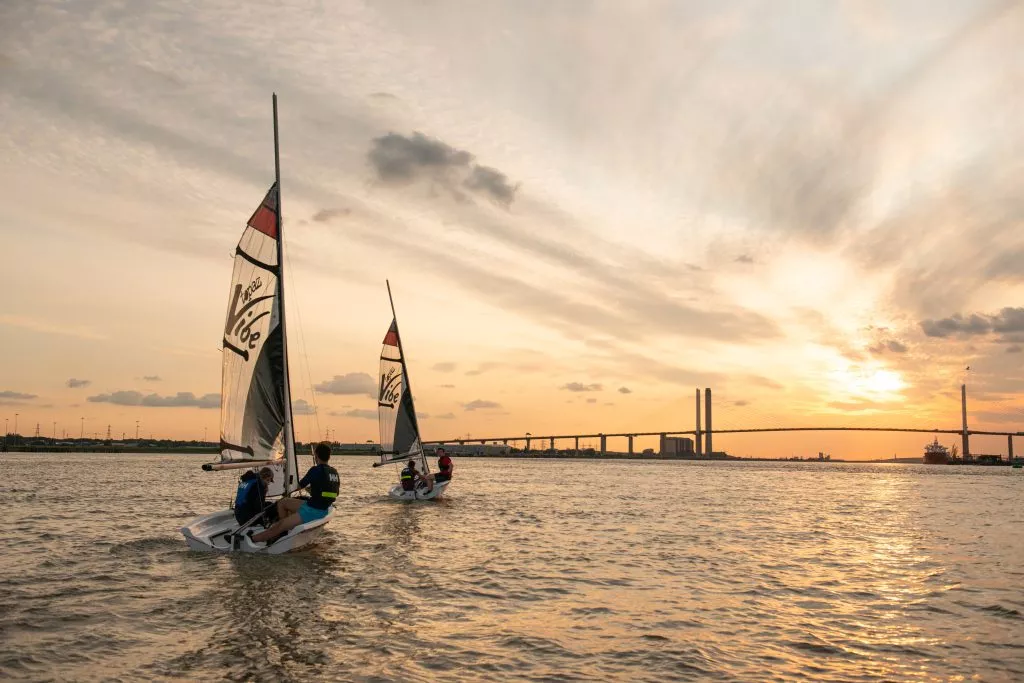
Sailing
Experience blue space
Taller vessels find London Bridge a barrier to further navigation, but there is still much to explore between London Bridge and the estuary.
Whilst some stretches of the tideway might not look busy at certain times, it is key to remember that it is a navigable port with a huge variety of activity, from stand-up paddleboarders to high speed boats and commercial ships. It is the busiest inland waterway in the UK.
In the upper river between Teddington and Putney, the channel is narrow with shallow depths, low bridges and many small recreational craft. The middle river, between Putney and the Thames Barrier, is very busy with commercial activity; tugs and tows, fast commuter ferries and day tripping boats all sharing the relatively narrow channel, which is tightly packed within the central London bridges. Once through the Thames Barrier the river widens and vessels start to become much larger and constrained to operating within the channel. These different challenges mean effective passage planning is vital and the information provided here should assist the recreational user in safely navigating the tidal Thames.

Sailing on the tidal Thames
Sailors should be aware that local byelaws exist on the Thames that in some circumstances give priority to motor vessels, contrary to what would be normal practice at sea.
As the tidal Thames is linked to the sea, all vessels need to follow the ‘International Regulations for Preventing Collisions at Sea’ (“Col Regs”). You can read the rules in full here.
When navigating in the tidal Thames vessels must keep as near to the starboard side of the fairway at all times, as is safe and practicable, or follow the recommended routes shown on our Recreational Users’ Guide. This does not mean that you can cross from one bank to another to tack along the river.
If you are crossing the river, it is to get to a set location for a particular purpose (i.e. to leave/get to a mooring) and you must not tack, cross or enter the fairway so as to obstruct another vessel proceeding along the fairway.
Keep a good look out at all times, behind you as well as in front.
If you find yourself approaching another vessel head-on, you should sound one short blast and keep to the Starboard (Right) When entering the river from a lock, pier or berth do not cross in front of another vessel.
At bridges, use the most starboard arch available to you provided it does not compromise your safety. (See the specific navigation advice for different areas of the river below, for more advice.)
Our byelaws contain rules which supersede some of the International Collision Regulations. For example:
- a vessel must not cross or enter a fairway so as to obstruct another vessel proceeding along the fairway.
- a vessel navigating above Cherry Garden Pier must not impede the passage of
- a vessel of 40m or more in length (above Westminster Pier, this length reduces to 20m)
- a vessel engaged in towing
Navigating in fog or restricted visibility
Navigating in restricted visibility is not an activity that the PLA recommends for any sport, leisure or recreational boaters on the tidal Thames. No attempt should be made to get underway when visibility is less than 200m and should you already be underway during an outing, you should find a safe haven as soon as reasonably practical.
Should the Master of a vessel decide to navigate in restricted visibility, you must have a comprehensive understanding of the International Regulations for Preventing Collisions at Sea, 1972 (COLREGs), in particular Part B (Steering and Sailing Rules) both Section III (Rule 19) – Conduct of vessels in restricted visibility and Section I (Rules 4 to 10 inclusive) – Conduct of vessels in any condition of visibility.
Put simply:
- A rigorous lookout should be maintained – by sight, sound and any means necessary.
- Navigation Lights are operational.
- Radar, if fitted, is setup appropriately and utilised to assist you in navigating in fog however it should not be solely relied upon.
- Navigate at a safe speed to ensure effective action can be taken to avoid a collision.
- MGN 369 – Navigation In Restricted Visibility contains further guidance.
Small vessels can also vastly improve their detectability by using Automatic Identification System,(AIS). An AIS transceiver can also assist small vessel crews in the early detection of ships, as well as showing names, call signs, speeds and headings of vessels in the locality to improve situational awareness.
Wash
At times the wash, or wave height, on the Thames can be powerful. The steep river walls reflect the wash, rather than dissipate it, so it can be particularly rough at high water during busy traffic periods. The Thames is classified as ‘Category C’ and ‘D’ waters with wave heights of up to 1.2m and 1.5m, so vessels should be suitable for the conditions.
Preparations
Ensure you have planned your passage; taken into account the tide times; made bookings with any locks; and checked the weather and ‘Fluvial Flow’ guidance. Check our Notices to Mariners page for anything that may affect your journey, such as river closures and bridge maintenance.
Everyone on board a recreational craft navigating on the tidal Thames should wear a lifejacket. The river is cold and fast flowing and can be harsh and unforgiving.
Pre-passage checklist
- check your backup engine (if fitted) is running satisfactorily
- check your bilge pumps operate correctly
- check the stern gland greaser is topped up and operates correctly
- check the horn is working correctly
- check the steering is working correctly
- check your anchor is correctly attached and ready to deploy (See Equipment section below)
Contact London Vessel Traffice Service, (VTS) with:
- name of your boat
- where you are entering the tidal Thames and your destination
- the time you expect to be on your way
- how many people are on board
- VTS can pass any pertinent navigational information to you too, such as river closures or bridge arch closures.
Always be aware of traffic moving up and down the river and enter the tidal Thames only when safe to do so.
We strongly advise all vessels to carry VHF. It is a requirement for vessels above 13.7m, but useful to all sailors.
(NB: exemptions exist for vessels travelling in a flotilla or convoy above Greenwich.)
Monitor VHF Channels:
- Channel 14 between Teddington to Dagenham (Crayfordness)
- Channel 68 from Dagenham to Southend Pier
- Channel 69 from Southend Pier.
If there is no VHF radio on board, the person in charge of navigation of the vessel should report to the London Vessel Traffic Service (VTS) by telephone (020 3260 7711 west of Dagenham, 01474 562215 east of Dagenham) prior to entering the tidal Thames.
Most chandleries sell VHF handsets, along with the ‘Ship Portable Radio Licence’ required for a VHF Digital Selective Calling (DSC) Handset. Contact your local chandlery for more advice on this.
If coming from the non-tidal Thames, Lindon Lewis Marine at Shepperton offer a VHF rental service. They can also supply river user guides and help with passage planning. (www.pushtheboatout.com)
Note: An RYA ‘Short Range Certificate’ (SRC) is the minimum requirement to use a VHF or VHF DSC radio (unless It is an emergency situation when anyone may use the radio to call for help) as well as appropriate licenses from OfCom. Contact OfCom and the RYA for more information.
The river is very busy with rowers and paddlers. Take a look at our Rowing and Paddling pages of the website to become familiar with what to expect. They follow the Tideway Code.
The river is narrow with very little water in places, so plan your passage carefully. Note that low bridges present an additional hazard; we suggest avoiding low water when navigating in this stretch of river.
The river below Putney presents a variety of challenges. Due to the high density of traffic and the number and low height of the bridges, a sailing boat is a rare sight in London beyond sailing events and races, until you get below Tower Bridge where clubs such as Greenwich Yacht Club are very active.
The Thames is the busiest inland waterway in the UK. The planning of your passage is essential.
The PLA Shop contains charts, bridges guides and tide programs to help you plan your passage.
We suggest, particularly for your first journey through London, to plan your passage for the quieter traffic times. (This tends to be either before 11:00 or after 18:00 during the summer months).
Traffic
The traffic in central London can get congested, particularly at peak times in the summer months. The areas around the Tower of London and Westminster / London Eye are especially busy, due to crossing vessels and sight-seeing passenger vessels.
Avoid impeding commercial craft wherever possible. They can be difficult to manoeuvre, take a long time to stop and may be confined to a small part of the river where there is just enough water for them.
Take particular caution when near vessels navigating with the tide behind them. This makes the steering and stopping of large vessels even more difficult than normal. If you are navigating against the tide, be prepared to stop or give way to vessels coming the other way.
Bridges
Through central London, the majority of bridges have multiple arches to choose from. You should use the arch which is furthest on the starboard side, where depth and height allow.
Two orange lights side-by-side mark aches which lie within the navigable channel – these, particularly the centre arches, are used by commercial vessels. You can still use these arches provided you remain on the starboard side of the river and you don’t impede commercial vessels.
Watch out for a white flashing light on the bridges. If it flashes, you MUST NOT USE THAT ARCH due to large craft or tugs approaching that arch. You must keep out of their way. They are restricted in their manoeuvrability due to their size, weight and the bridge arches.
If you intend to head to the east of London passed the O2 Dome, review the PLA's guidance for navigating the Thames Barrier.
The tidal Thames is categorised by the MCA (Maritime Coastguard Agency) as a ‘Category C’ waterway down as far as Gravesend. This means that you can expect wave heights of 1.2m, so it is important to ensure your vessel and the equipment it carries is up to the task. (This increases to ‘Category D’ downriver of Gravesend.)
We recommend the following equipment when navigating on the tidal Thames:
- Lifejackets: approved by MCA or under the Marine Equipment Directive (MED), or should comply with BS EN 396: Lifejackets and personal buoyancy aid of 150N, or BS/EN 399: Lifejackets and personal buoyancy aids of 275N
- a VHF set (mandatory for some vessels)
- mobile phone (in a waterproof pouch)
- water resistant torch
- suitable boat hook
- appropriate first aid kit
- navigation lights if navigating during darkness or reduced visibility
- ropes for mooring the vessel and for towing
- minimum of one 12kg anchor, attached to a designated strongpoint by 5 metres of 6mm short link chain and 25m of 12mm rope.
Additional information from the RYA:
An AIS transponder (Automatic Identification System) is of a great benefit. An AIS transceiver can assist small vessel crews in the early detection of ships, as well as showing names, call signs, speeds and headings of vessels in the locality to improve situational awareness.
For some vessels, particularly narrow boats or boats that were designed for canals and non-tidal rivers, the distance between the water and vents, hatches or drains may be quite small. Safety Bulletin No.1 of 2012 was published following an incident where there was inadequate freeboard or safety clearance.
The recommendations are as follows:
- The tidal Thames is classified as Category C waterway, where wave heights of up to 1.2m may be encountered. Vessels should be suitably prepared to meet these conditions.
- Through hull fittings, vents and exhaust outlets should be positioned as high up as practicable on narrowboats to meet the conditions likely to be encountered. Where through hull fittings, vents and exhaust outlets cannot be moved to a safe location consideration should be given as to whether the vessel is suitable to navigate on the tidal Thames.
- Where modifications have been made, such as the extensive use of double plating, it is important to check sufficient safety clearance remains for the vessel to safely navigate.
- Lifejackets and other safety equipment should always be provided on board vessels navigating on the tidal Thames and it is strongly recommended that lifejackets are worn at all times when on deck.
It is important to ensure that the engine and controls of the vessel are in a good state of repair.
Although there is not a legal requirement for the person in charge of a recreational craft to have a formal qualification, the tidal Thames is not for novice or inexperienced people.
A good degree of boating knowledge and experience is needed before venturing on to this complex and challenging river. With all watersports, it’s best to learn under the guidance of an experienced and qualified coach. They can make sure your introduction to the sport is fun and safe and- added bonus- signpost you to the best clubs and paddling routes in your area.
The RYA has a wide range of courses which assist boat users to become safe and proficient.
Note:
- vessels that are hired or chartered are not considered to be pleasure vessels.
- a vessel carrying more than 12 passengers is not classed as a pleasure vessel, but would come under the definition of a ‘passenger vessel’. The vessel and the skipper would then require appropriate licences from the Maritime Coastguard Agency (MCA). Contact your local MCA office for further details.
Activity finder
Sailing resources
Going afloat: What you should know
